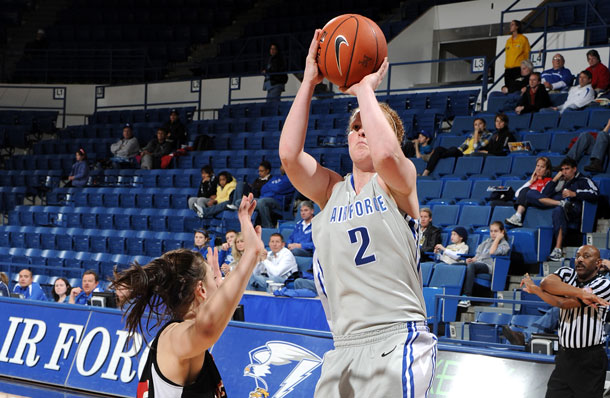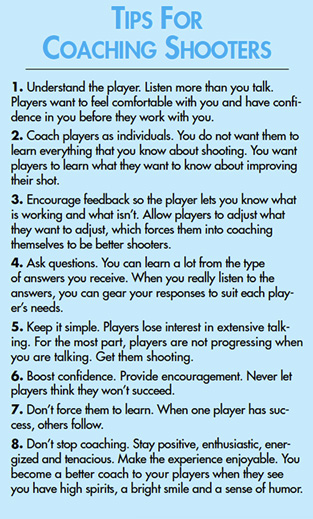A plan to turn good shooters great
Every player on your team wants to be a better shooter. But, becoming a better shooter takes dedication to the physical and mental side of the act of shooting. If players understand the proper mechanics and the proper thought process involved in shooting, then they should be able to overcome any bad mechanics they may have picked up prior to reaching your level of play.
Mental giants
When working to improve your players’ shooting, begin with the mental side of the action. The first place to focus is player confidence. It’s your job to make your player believe in their shot. Tell your player that shooting is much more than mechanics. It’s a feeling, a thought and a belief that the shot is going in every time.
 Some players have a difficult time believing that the ball in their hands is going to fit through that small, orange rim. To convince them, get a ladder and show them that three-and-a-half basketballs actually fit inside a rim. This surprises most players. Realizing the basket is much larger than they thought gives players a psychological boost to their confidence.
Some players have a difficult time believing that the ball in their hands is going to fit through that small, orange rim. To convince them, get a ladder and show them that three-and-a-half basketballs actually fit inside a rim. This surprises most players. Realizing the basket is much larger than they thought gives players a psychological boost to their confidence.
Developing confidence also comes from a proper followthrough while shooting. Following through is important to the physical aspect of shooting, but it also plays a mental role. Have your players follow through until the ball touches the rim. This makes them look more like shooters, so they feel more like shooters.
Finding a rhythm
Shooting is more than a mental exercise. After building mental strength during the shooting process, teach players that confidence comes from having a shooting rhythm. Before breaking down the mechanics of each player’s shot, stress the shooting rhythm as a key to success. A shot needs to be free flowing with all parts of the shot flowing together in a sequential rhythm.
To establish this rhythm, have players use an up-and-down motion of their legs rather than lowering the ball or stepping into the shot. The up-and-down motion starts with the knees slightly flexed, then have players bend their knees and fully extend them in the up-and-down motion. Say words like “down and up” to drive the point home as players work on this motion.
Next, work the arms into the shooting motion. Legs and arms need to work rhythmically together. As legs go up, arms go up. As legs reach full extension, a player’s back, shoulders and shooting arm extend in a smooth, continuous forward and upward direction toward the target. The ball should be high with the shooting hand facing the rim. Keeping the ball high fosters a quick release and diminishes the chance for error.
Don’t have players step into the shot, as this might help their range but the shot loses its rhythm. More range does not equal more accuracy. The goal is to get players knocking down more shots. Range comes with time.
Add keywords
Boosting confidence and establishing a rhythm to the shot puts players in a position to shoot better. Now, they need to use keywords to stay on task. Players need to pick an “anchor” word that positively reinforces the visualization of a successful shot. For example, tell your players to think “Through! In! Yes! Net! Swish! Whoosh! Face!” every time they shoot.
Players also need “trigger” words to focus on mechanics. Have them repeat words such as:
- High! — to have players start the shot high and prevent lowering the ball.
- Straight! — to make the shooting hand go straight to the basket without turning the wrist.
- Front! — to key on the position of the shooting hand facing the rim.
- Point! — to key the correct release of the ball off the index finger.
- Up! — to key on a high arch.
- Through! — to focus on follow-through including shoulders, arm, wrist and finger.
- Head in! — to focus on the follow-through of head and shoulders toward the basket.
- Legs! — to key on the proper use of the legs.
- Down and up! — to focus on the proper rhythm of the legs for the shot.
 When players work on shooting, have them repeat two trigger words (areas they need the most work) and their anchor word. For example, a player who needs to keep his hand straight and focus on his legs should repeat to himself, “straight, legs, yes!” Saying personalized key words in an even rhythm establishes a rhythm for the shot while enhancing mechanics and confidence.
When players work on shooting, have them repeat two trigger words (areas they need the most work) and their anchor word. For example, a player who needs to keep his hand straight and focus on his legs should repeat to himself, “straight, legs, yes!” Saying personalized key words in an even rhythm establishes a rhythm for the shot while enhancing mechanics and confidence.
Make sure players don’t use too many words. This causes too much thinking, taking away from the natural flow and rhythm of a shot. The goal is to reduce conscious thought and promote automatic execution of the shot. As shooting improves, one trigger word may suffice. Eventually, an anchor word may be all a player needs to trigger the automatic action of a shot.
Detecting errors, providing solutions
The following are the nine most common shooting problems and how to correct them.
1. The shot is short. Short shots are caused by the player not using the legs, an incomplete follow-through, or a slow, uneven rhythm. Emphasize that force comes from the legs, that a complete follow-through comes from keeping the arm up until the ball reaches the basket. Always stress an even rhythm.
2. The shot is long. The shooting arm is extending a flat trajectory — less than 45 degrees. The player should raise the shooting arm higher (45 to 60 degrees) to create a greater arc. Stress the head and shoulders moving forward and upward as part of the follow-through. Also, check the player’s hands and make sure they are not too far apart.
3. The shot is inconsistently short or long. The shooting arm should be extended with complete elbow extension on the follow-through.
4. The shot hits the right side of the rim (right-handed shooter). Either the player is not square to the hoop or the player is starting the shot with the ball in front of the head, with the elbow out, causing the arm to extend to the right on the shot. The player should set the ball on the shooting side of the head between the ear and shoulder with the shooting hand facing the front of the rim.
5. The shot hits the left side of the rim (right-handed shooter). Once again, the player may not be square to the hoop. Or, the shot may be starting on the player’s right hip or too far to the right, resulting in shoving the ball from right to left during the shot. Instruct players that power comes from the legs, not by shoving the ball.
» ALSO SEE: Grinnell’s 7 drills to improve 3-point shooting
6. The shot lacks range, control and consistency. The ball is being lowered or brought behind the head or shoulder during the shot. This causes the player to throw the ball and use an inconsistent follow-through. Emphasize the down-and-up motion of the legs and a complete follow-through. Also, have the shot begin on the shooting side between the ear and the shoulder with the shooting hand facing front.
7. The shot hits the side of the rim and circles out. The ball is being shot with sidespin, most likely caused by the player’s shooting hand being on the side of the ball and rotating that hand too much. An over-rotation causes the ball to hit the right side of the rim with sidespin and roll left. An under-rotation has the opposite effect.
Other causes are starting the shot on the palm and letting the ball slide off the ring finger rather than shooting off the index finger, as well as moving the hand too much on the ball and thumbing the ball with the non-shooting hand. To prevent thumbing from the opposite hand, place the ring finger and pinky of the non-shooting hand under the ball. Squeeze the thumb and index finger of the non-shooting hand together. This helps the player to shoot only with the shooting hand.
8. When shooting off the dribble, the shot misses either right or left. The player is reaching to the side for the ball and starting the shot from the side of the body. Instead, the player needs to dribble to the front of the shooting knee, jump behind the ball, and pick up the ball with the shooting hand on top of the ball.
9. When shooting off the dribble, the player floats forward, back or to the side. Once again, dribble to the front of the shooting knee. Pick up the ball in front of the shooting knee (shooting hand on top of the ball) with the knees flexed to gain balance for the shot and to prevent floating.
Hal Wissel is a former NBA assistant coach and a head men’s college coach. He’s the owner of Basketball World, which offers camps, clinics and instructional tools. This article was published by Winning Hoops in 2007.









